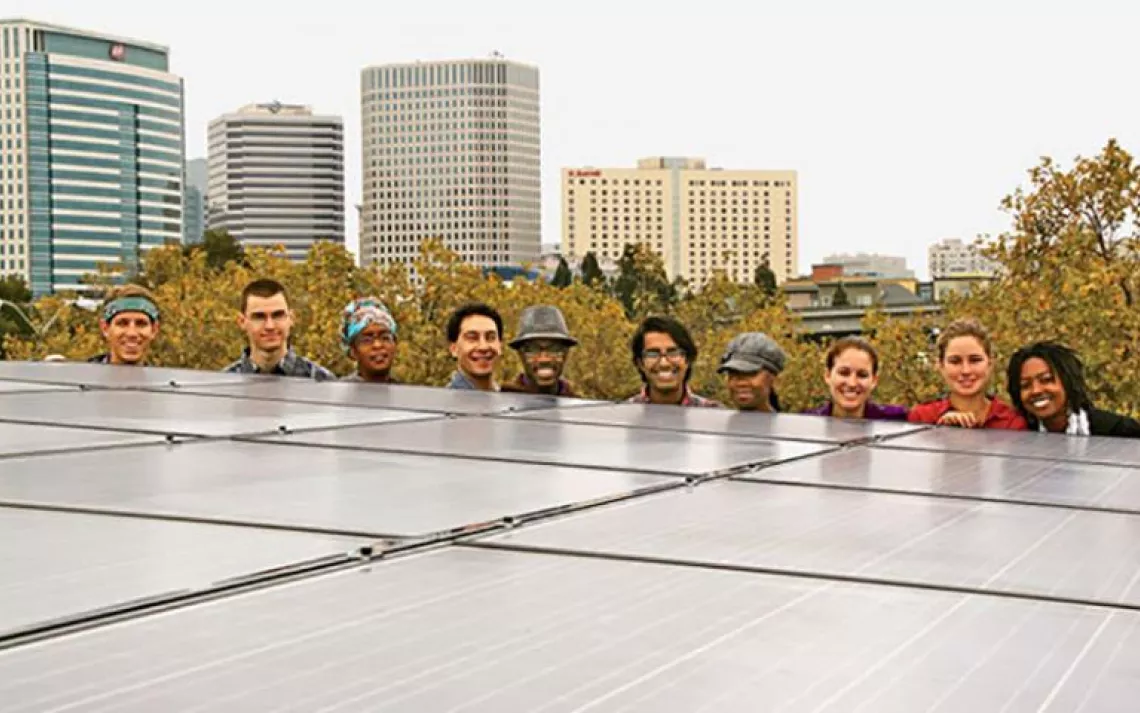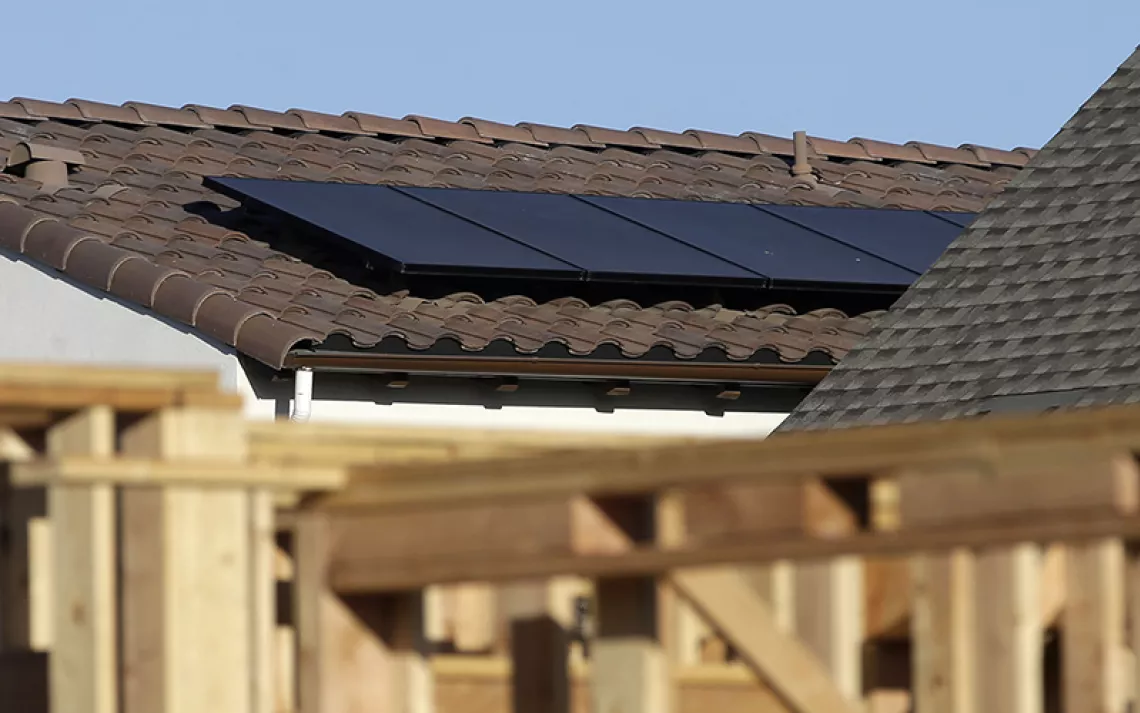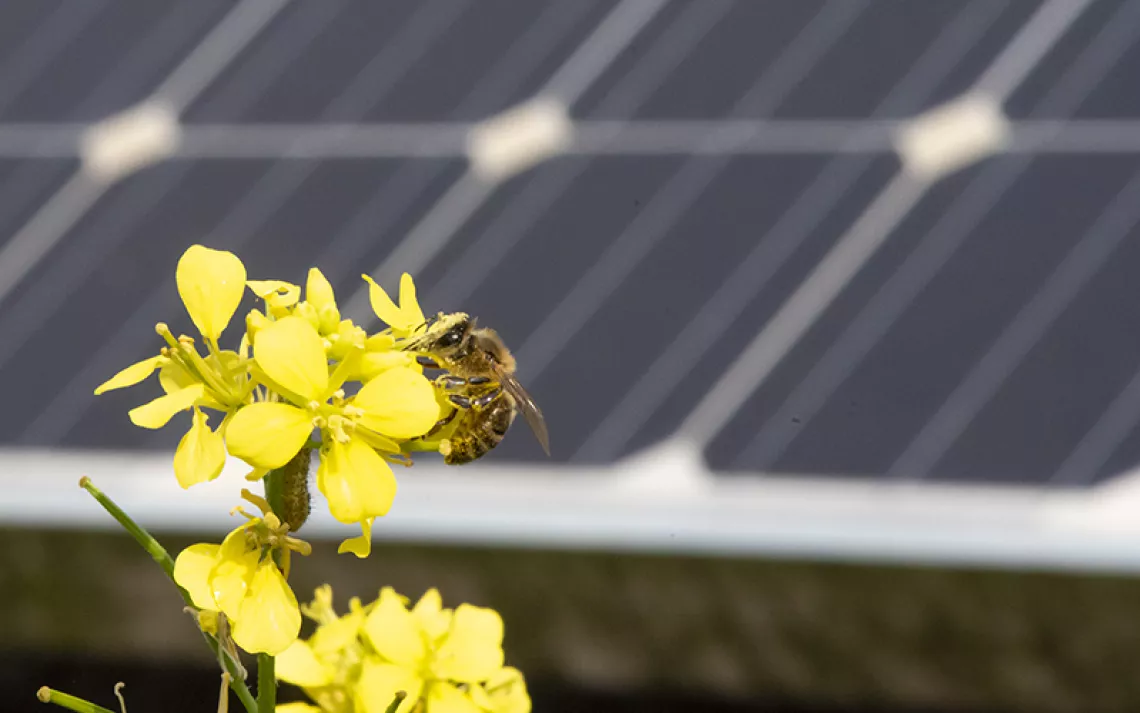Solar for All
Until now, rooftop solar has only worked for those with hefty electric bills and sunny roofs.

Working through Mosaic, 70 community members financed this 8.6-kilowatt solar project on top of West Oakland's People's Grocery, which will save the food-justice project $32,000 over the next 20 years.
I REALLY WANTED THE FIGURES TO WORK OUT. So did Ricky, the nice young guy from Sungevity who was trying to lease me a solar array for my roof. My family was looking into a 1.7-kilowatt system—the smallest available. Even so, our miserly habits kept us firmly in our utility's lowest—and cheapest—tier of electricity usage. Solar is getting cheaper fast, but the numbers for the popular lease-financing model wouldn't pencil out unless we could somehow boost our energy usage into a higher tier.
"How about a plug-in Prius?" Ricky suggested helpfully. "That would make it work."
Unfortunately, even though a Prius driven 30 miles a day would increase our electricity use by 165 kilowatt-hours a month, a new car isn't in our budget—and so (for the time being, at least), neither are solar panels on our roof. That puts me in good company: Some 75 percent of Americans rent, live in condos, have roofs shaded by trees or other buildings, or are otherwise poor candidates for sun power. Which leaves us out of the clean energy revolution that's going on across the country.
If "revolution" sounds like hyperbole, consider this: U.S. solar installations more than doubled from the second quarter of 2011 to the second quarter of 2012. Last August, California's utility-scale solar plants hit 1 gigawatt—as much energy as can be generated by a large coal- or nuclear-fired power plant. Less remarked on during the celebration of that milestone was the fact that at the same time, "distributed solar"—the thousands of rooftop systems in the state—was exceeding that number by 20 percent, producing 1.2 gigawatts. In 2008, the National Renewable Energy Laboratory put the annual technical potential of rooftop solar in the United States at 819 trillion watt-hours, equal to about a fifth of the nation's 2011 electricity demand.
Along with the increase in capacity, solar prices are plummeting, thanks to technological advances and fierce competition from China. Within two to three years, says John Farrell, senior researcher at the Institute of Local Self-Reliance in Minneapolis, both California and New York will achieve "grid parity." That's the golden moment when power from the sun becomes as cheap as average residential electricity. Hawaii is already there; in Honolulu, 41 percent of building-permit applications these days are requests to install solar systems.
"The economics continue to drive solar forward," Farrell says. "But there's still a big barrier. The economics are going to allow a stampede of folks who are well placed financially, and in terms of the property they own, to go solar. But it's leaving everyone else out."
So, what if I don't want to be left out? Couldn't I get together with the other 75 percenters in my neighborhood, put some solar panels on the local recreation center, and reap the benefits?
Many other people across the country are asking the same question—and some are succeeding in establishing a form of "community solar" or "solar garden." In Minnesota, members of the Wright-Hennepin Cooperative Electric Association can own part of a 39-kilowatt array of locally made panels on the roof of the co-op's headquarters, allowing them to share in the electricity just as they would with a system on their own roofs. California's forward-looking Sacramento Municipal Utility District lets customers purchase solar power from a local "solar farm," receiving the same full retail credit per kilowatt-hour that they would from a home system. And in Washington State, members of the nonprofit Backbone Campaign can invest in a 50- to 66-kilowatt solar array erected at a recycling transfer station, with a forecast return of 13.5 percent a year until 2020.
Nice for them, but not so much for me and my neighbors on Oregon Street. Our utility is of the big for-profit, investor-owned sort, not a cooperative, and I am neither a Washington resident nor a member of the Backbone Campaign, which means I'm prohibited by financial regulators from participating in its program. However good an idea community solar might be, achieving it requires surmounting a daunting string of institutional hurdles. "Community solar happens for innovative citizens," Farrell says, "but always against the odds."
Let's look at the obstacles facing my dream community solar project. For starters, my neighbors and I would need some capital, but banks aren't much interested in financing penny-ante solar arrays. Our numbers wouldn't look very good anyway, because a still-essential ingredient in solar's success is the 30 percent federal tax credit, and as a nonprofit, we wouldn't be able to take advantage of it.
If we somehow did manage to scrape together the installation money, we'd need to sell the juice our panels generated to our local utility. But what would be in it for them? Even in a state like California, where utilities are obligated (up to a point) to accept new residential solar applications, nothing requires them to deal with the Oregon Street Cat Fanciers' Solar Co-op. If they did, they'd have to come up with a billing system that would credit me and my neighbor Doris and the cat lady down the street proportional to our stakes in the project—something Pacific Gas and Electric Company (PG&E) has zero motivation to do.
In short, the chances of our plucky little neighborhood powering its blenders, DVRs, and iPads with shared solar look very poor. To triumph against the odds, community solar needs a model that can work within the current regulatory system (unhelpful as that may be) and that is widely replicable. Happily, two organizations (at least) appear to have such a model: Colorado's Clean Energy Collective and California's Mosaic.
Paul Spencer is founder and president of the former. He got into community solar after trying to design a "net-zero" community of 89 homes in Carbondale, Colorado, that would draw its power from a centralized solar system. The housing market collapse killed the project, but Spencer and his group resolved to craft a widely deployable model for community solar. It took a year and a half of running the numbers on dozens of different options before they settled on the rather uncollective formula of individual ownership.
"WE FOUND THAT THE GREATEST BENEFIT FOR THE CONSUMER was always realized in the case where they owned the panel," Spencer says. He admits that it would have been easier to adopt a lease-financing model, like that used by Sungevity and others, to market solar arrays to individuals. But just as with those personal rooftop systems, outright ownership of a panel in a solar garden gives a better rate of return than does leasing. So if we do start that solar garden on top of the rec center, I would own a panel, Doris would own a panel, and the cat lady would own three because she has to run the can opener so much.
The tricky part, Spencer says, was figuring out how to take advantage of the federal tax credit. "The IRS tax code," he notes dryly, "was not written to support community solar." For instance, it doesn't allow individuals to take the credit if the solar equipment isn't physically on their property. Since the corporate tax code does, the Clean Energy Collective holds technical ownership of the panel for five years, sells the tax credits to someone who can use them (usually a big bank), and discounts the up-front expense to consumers accordingly—which allows them to buy in for as little as $525.
Once the solar garden starts producing, the project's customers receive a straight dollar credit on their utility bills. This is different from the usual arrangement for individual homeowners with rooftop panels, most of whom take advantage of a policy called "net metering": When the sun is shining, their electric meters spin backward. They get credit for the power they produce, but only up to their average electricity usage. Power produced beyond that just goes into the grid—and typically at a time of day when electricity demand is highest and power the most valuable. That's why the policy is popular with utilities.
Some community solar advocates would like to adapt this system to solar gardens via a policy they call "virtual net metering" or "community net metering." In my neighborhood's case, this would require our utility to credit me, Doris, the cat lady, and all the other co-op members for the energy produced from the panels on the rec center. That would do the trick, but utilities hate it. The Clean Energy Collective model avoids this fight entirely by simply selling power to the utility as if the collective were operating a small power plant. Doing so, Spencer says, "allows us to speak their language." The utility doesn't have to change its accounting practices to credit the community solar members because Spencer's group provides metering software that takes care of everything. The simplicity of this arrangement leads solar expert Farrell to call the Clean Energy Collective the "only consistently replicable community solar model." It now has 14 projects totaling 5.3 megawatts operating or under construction in Colorado, New Mexico, and Minnesota.
"We're one of the only solar companies I know that actually partners with the utility, as opposed to shoving it down their throat," Spencer says. "You have to understand their mentality. Why not allow everybody to win? Utilities meet their goals, consumers meet their goals, and we end up with a hell of a lot more solar." That, after all, is community solar's goal—to provide more solar in general, not necessarily for particular individuals. Electrons from the panels on the rec center wouldn't necessarily flow into my toaster, but they would increase the total amount of solar power in our town—and hopefully make me some money too.
Hitting community solar's sweet spot from another angle is Oakland, California-based Mosaic. Housed among a host of other solar start-ups in the airy waterfront offices of solar-leasing giant Sungevity—imagine big views of the San Francisco Bay, lots of laptops, and exercise balls instead of chairs—Mosaic crowd-funds solar projects, enabling people to invest directly in small to midsize solar projects while earning annual returns of 4 to 8 percent.
Financing is a major hurdle for community-scale solar. Very few banks finance solar projects, and those that do favor big ones—either utility-scale solar operations or solar-leasing companies that front thousands of rooftop projects. When it comes to serving the needs of Oakland's Asian Resource Center or St. Vincent de Paul Society, or the Murdoch Community Center in Flagstaff, Arizona, it's not worth the banks' time to do the risk analysis involved.
Enter Mosaic. In the case of St. Vincent de Paul, it rounded up 80 supporters who kicked in a total of $88,000 to finance 26 kilowatts of solar panels to power the organization's kitchen, where volunteers prepare a thousand meals a day for Oakland's homeless and indigent. All those walk-in freezers and refrigerators require a lot of electricity, says St. Vincent executive director Philip Arca. The solar panels are saving about $1,200 a month, he says, adding, "We want to get as much assistance to people as possible, so for us every dollar counts."
This project, like Mosaic's other early endeavors, was a test in which the "investments" were actually zero-interest loans. A new project, installing 47 kilowatts of panels on the roof of Oakland's Youth Employment Partnership, a job-training nonprofit, is Mosaic's first to offer a real return on investment—in this case, an attractive 6.38 percent. At present, the Securities Exchange Commission is limiting the offering to no more than 35 "non-accredited" investors (i.e., ordinary folks as opposed to millionaires), since it considers the offering to be speculative. Mosaic has been involved in lengthy negotiations with the SEC, says the company's "community builder," Lisa Curtis, trying to get a more general approval of its model, which would open up solar investments to the public at large.
"We think of ourselves as a solar finance company," Curtis says. "Our model recognizes that we now have the power of the Web to bring people together—so people in Michigan, for example, a place without great solar resources, could still put their money to work creating clean energy. We hope to show that solar is not only economically viable; it's also profitable."
Should Mosaic get SEC approval—which it is confident will be forthcoming—to offer shares in community solar facilities to ordinary investors at interest rates of 4 to 8 percent, Farrell says, that would be a game-changing advance. "If it becomes relatively inexpensive to raise capital for community-based projects," he says, "that really blows the door down."
READY FINANCING WOULD BE A BIG BOOST for community solar—or any kind of solar, for that matter—but it can't take the place of smart public policy. A good example is the 2010 legislation in Colorado that created the opening for solar gardens. It took the state's public utility commission almost two years to write the necessary regulations, so it wasn't until last August 15 that Xcel Energy, the state's largest utility, started accepting applications to build them. Xcel shut the process down in 30 minutes, after receiving proposals for three times the 4.5 megawatts released in this round of the program—most of them from the Clean Energy Collective.
Even more striking are the policies enacted in Germany, which boasts more than a million solar systems, four times as many as the United States despite the fact that it has about one-fourth of the population. Last May 26, these mostly rooftop arrays produced 22 gigawatts—enough to meet half the country's electricity demand. It's worth noting that the "insolation," or sunniness factor, of Germany is worse than that of everywhere in the contiguous United States except rainy Seattle.
What does Germany have going for it that we don't? For starters, Germans have focused their famous efficiency on cutting costs. Installing a rooftop solar array in the United States costs about $20,000, but in Germany it costs about half that—because nearly every element of the transaction is simpler and cheaper. In the United States, cities typically require reams of permits, with regulations and fees varying widely from one town to the next. (In California alone, permit fees range from nothing to $888.) In Germany there are no fees, and only a simple, one-page online registration is required. There's also no sales tax for solar installations, and permission to connect your system to the local utility is a given.
Even more important, Germany subsidizes solar power by guaranteeing a fixed price plus a reasonable rate of return—a policy known as "solar cash back" or "feed-in tariff." That makes solar a solid, simple investment—one as secure as a savings account. The annual rate of return declines over time, which encourages people to install their systems sooner rather than later. It also creates pressure on solar installers to become more efficient and to cut costs, so solar investors can get the most out of their euros. Gainesville, Florida, has such a policy; consequently, Mosaic is seeking to develop community solar projects there. Los Angeles is using its feed-in tariff—which was cosponsored by the Sierra Club—to help it get to 300 megawatts of rooftop solar by 2016.
Were he made U.S. energy czar, Farrell says, his first move would be to institute a national feed-in tariff: "Then you don't have to mess around with anything else." Of course, one might wish for a tax on carbon too, but neither policy is very likely in the current political environment. A more probable path to widespread community solar is to improve—or at least extend—the existing federal tax credit for solar installations. That credit expires in 2016, and any solar developer who watched Congress gridlock over extending the tax credit for wind has to be getting the heebie-jeebies. "Without the tax credit," says the Clean Energy Collective's Spencer, "these things do not work."
That doesn't mean, however, that the credit needs to stay exactly as it is. The current system is tailored to banks or large investors who have big tax liabilities. Thus, small and mid-level developers end up selling their credit to banks at a big discount. So, Farrell says, if the tax credit were replaced by a cash grant, the financing of community solar projects would be much simpler and more efficient. Also, he says, "the federal government would get a lot more bang for its buck out of a cash option because people wouldn't need a middleman." While a grant system may not sound politically likely, Congress actually enacted such a program from 2009 to 2011—a $9 billion effort that enabled 23,000 clean energy projects, enough to power 3.4 million homes.
Another way to boost solar, wind, and renewable energy of all stripes would be to establish or increase statewide renewable energy standards (a.k.a. renewable portfolio standards), which dictate the amount of clean energy a state's utilities must provide by a certain date—20 percent by 2020, for example. They're what give utilities an incentive to buy solar power in the first place. Thirty-three states and the District of Columbia currently have such standards, 16 of which require that a certain percentage of that clean energy be solar. New Jersey, for example, requires a 4 percent solar share, and consequently has a high rate of solar installations.
As reasonable as such policies are, they're still a heavy lift. Last August in California, two bills that would have vastly expanded community solar were quashed by the state's powerful utilities. One, known as "Solar for All," would have established a small feed-in tariff to promote solar gardens and other renewable energy projects in low-income communities; the other would have let Californians purchase shares in solar facilities and get credit on their energy bill for the clean power produced. It could have added up to 2 gigawatts of power to the state's grid, but intense lobbying from two of the state's largest utilities—which complained that the power generated would not count toward their renewable-energy-standard goal—killed it in committee.
"Unfortunately," said the bill's author, state senator Lois Wolk, "PG&E and Southern California Edison control the committee."
Community solar doesn't have to be forced on utilities, as Colorado's Clean Energy Collective has shown, but it does represent a challenge to their business model. Absent a major feed-in tariff like Germany's, the solar panels you put on your roof are for your own personal use, with any surplus conveniently available to the utility at the time it needs it most.
But if my neighbors and I figure out how to launch our solar co-op, and the folks on the next block do the same, and the next block after that, eventually our utility is going to start running out of customers, and will exert what political juice it has to slow the process. But that can only last so long. Remember grid parity—when solar power becomes as cheap as or cheaper than electricity from fossil fuels? When that time comes, neither lobbyist nor bureaucrat will be able to hold back the clean energy tide, and the cat fanciers of Oregon Street will toast their bagels with sunbeams.
 The Magazine of The Sierra Club
The Magazine of The Sierra Club







